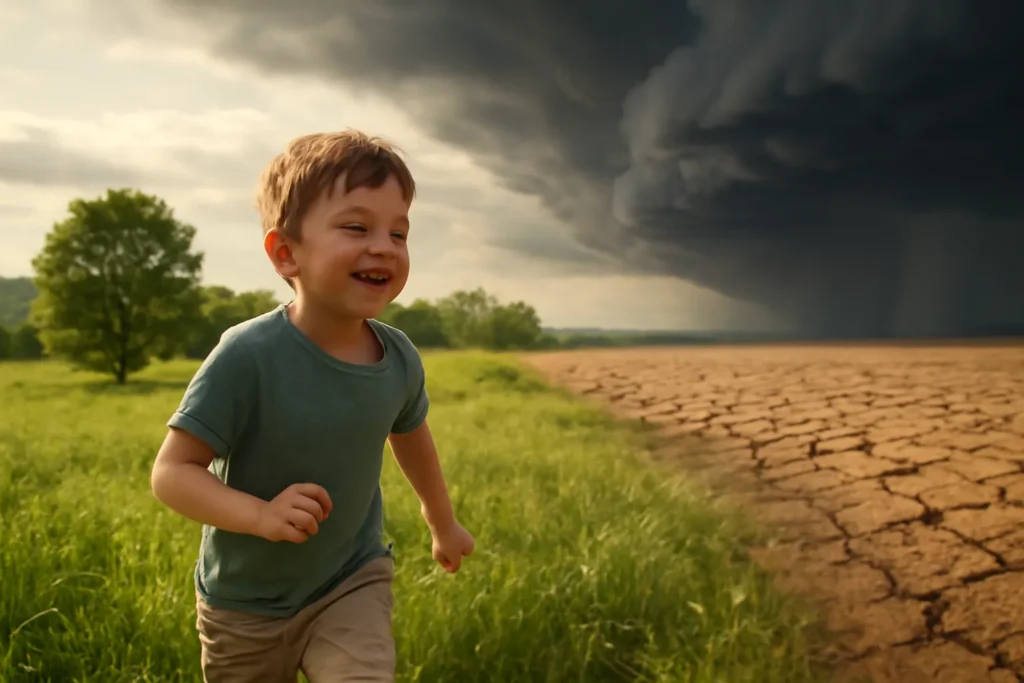The Stark Reality: Children Face a Future Defined by Climate Extremes
Imagine being born into a world where your first steps might be on parched earth, your school days disrupted by searing heatwaves, and your adolescence marked by ever-worsening floods and wildfires. For children born in 2020, this isn’t a scene from dystopian fiction—it’s the new normal painted by a sweeping body of climate research from leading institutions like Nature, Save the Children, and Vrije Universiteit Brussel. The data is unambiguous: today’s children are poised to encounter climate turbulence on a scale unparalleled in recorded history.
According to the study published in Nature, children born in 2020 are projected to be two to seven times more likely to endure catastrophic weather events such as one-in-10,000-year heatwaves, megadroughts, and floods compared to their grandparents born in 1960. The Inter-Sectoral Impact Model Intercomparison Project (ISIMIP) provided a rigorous foundation, simulating climate outcomes over multiple generations and global scenarios. While extreme events were once statistical outliers, children today face the prospect of these disasters becoming recurring chapters in their life stories.
Such projections aren’t abstract. The past decade alone has brought unprecedented wildfires across Siberia and California, devastating floods that swallowed towns in Libya and Pakistan, and heat domes gripping Europe and the Pacific Northwest. These new weather patterns, says Dr. Wim Thiery, climate scientist and senior study author, are expected to accelerate further—even if global warming is capped at 1.5°C above pre-industrial levels. Already, almost four in five children under 12 report feeling worried about climate change, a finding backed by a recent UNICEF poll that paints a sobering picture of eco-anxiety permeating childhood itself.
What’s fuelling this rising tide? Decades of inaction and policy gridlock have left our youngest generations bearing the brunt of a crisis they did not cause, raising existential questions about intergenerational justice and political responsibility.
Running the Numbers: Children as the Biggest Losers of Climate Inaction
Beyond unsettling anecdotes, the new research offers a deeply quantified look at just how much more our children will have to contend with. If the global trajectory continues along its current path—projecting 2.7°C warming by 2100—studies anticipate that 83% of today’s five-year-olds will endure unprecedented heatwaves in their lifetimes, compared to a mere 16% of those born in 1960. For heatwaves specifically, numbers become even starker under a 3.5°C scenario: up to 92% of children could experience deadly temperatures, 29% could see major crop failures, and 14% will confront historic floods during their most formative years.
“Our research shows that dangerous exposures are not distributed equally,” notes lead author Dr. Thiery. “Children in the Middle East, North Africa, and other vulnerable regions will shoulder a disproportionate share of extreme climate events, further entrenching global inequities.” Even within wealthier nations, it’s often communities of color or the economically disadvantaged who have fewer resources to prepare for or recover from calamities.
The numbers are not just cold statistics; their implications are wrenchingly human. Heatwaves and floods will force schools to shutter, cut off access to food and clean water, and jeopardize the health and development of countless young people. The mental health toll is already being tallied, with psychologists sounding alarms about the long-term consequences of chronic climate fear and trauma among youth. How do you explain to a child why their childhood must be defined by crisis?
“If global emissions continue unchecked, we are not only condemning millions of children to a lifetime of climate trauma, but also undermining our collective ability to build a resilient, equitable future.”
— Save the Children Climate Advocacy Report
Conservative policymakers who tout deregulation or dismiss the need for bold emissions cuts often argue costs are too high or changes too disruptive. But Harvard climate economist Gernot Wagner points out that the real cost lies in inaction. “Spending now prevents exponentially higher damages—economically and morally—in the decades ahead,” he told the Financial Times.
Climate Action as Child Protection: Progressive Policy Imperatives
A closer look reveals that limiting warming to 1.5°C is more than an aspirational target—it’s a potential lifeline for today’s youth. The ISIMIP simulations show that meeting this goal would spare eight million children from crop failures, five million from river floods, and millions more from cyclones, droughts, and wildfires. Put bluntly, ambitious climate action translates directly into millions fewer shattered childhoods and futures cut short.
Progressive climate policies aren’t luxuries for the privileged; they are necessities for safeguarding the rights and wellbeing of every child. Opponents argue that aggressive mitigation might limit economic growth or require difficult trade-offs. Yet evidence from countries like Denmark and Germany illustrates the opposite: investing in clean energy, resilient infrastructure, and sustainable agriculture can actually bolster economies and create more equitable opportunities—without sacrificing ambition for the next generation.
History provides stark warnings about the dangers of incrementalism. The slow global response to acid rain in the 1980s created healthcare and environmental costs that greatly exceeded what could have been invested in prevention. Will we repeat those mistakes or rally behind a common cause to protect the most vulnerable among us?
Climate action is ultimately about fairness—giving each child a chance at a safe, stable life. According to a recent Pew Research study, more than 60% of Americans now agree that bold government intervention is necessary to address the climate crisis, particularly when children bear the greatest risk. The data, the stories, and the voices of millions of anxious young people converge on one truth: Our policy choices now will define not just environmental outcomes, but the destinies of entire generations.

